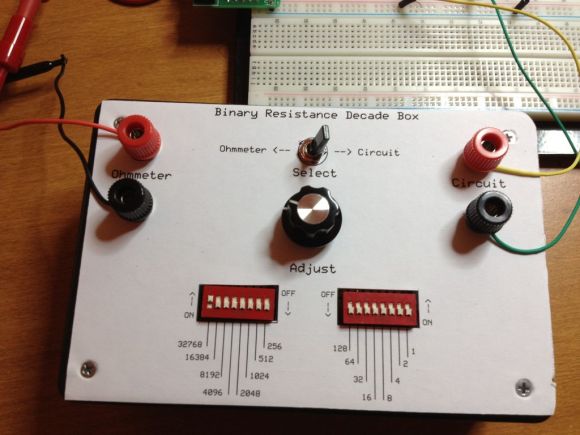
Here’s a simple piece of equipment which you’ll be proud to display on your electronics bench. It’s a resistance decade box. The concept has been around forever — it offers the ability to tune a wide range of resistance values just by adjusting the controls. We especially like the clean look of this one, and think the use of DIP switches is a nice touch.
Check out the toggle switch at the top. It lets you disconnect the resistance values from the output in order to test them with your meter. It may not seem like much, but fudging your switch settings could end up smoking your target project. The value of that feature isn’t lost on us.
The DIP switches are mounted to some Radio Shack breakout boards which work perfectly for hosting the resistors as well. This keeps the inside of the enclosure nice and tidy. The final touch is the printed face plate applied to the cover of the box.
Like we’ve said, this one is nice but our favorite is still this one that uses thumbwheel switches to dial in a value.















Nice and clean. Building something like this is on my list of things to do.
Just wanted to point out: doesn’t “decade” imply factors of 10 (1, 10, 100, 1k, etc.)?
Yeah, I thought about the “decade” thing. But the term “Decade Box” means something to people in electronics and I wanted to make sure the device’s purpose was clear. Binary Box just didn’t cut it! Thanks for your comment.
This looks real pro. I would be a little concerned about the life rating on dip switches though.
Thanks, Pete! I share your concern. I’m primarily working with 5V, low current circuits, but I looked around for the sturdiest DIP switches I could find and settled on GC Electronics 35-968. They’re rated at 100mA @ 50V carry and 100mA @ 5V (or 25mA @ 25V) switch.
Those electrical specs seem pretty good. A typical DIP switch is only rated for ~2000 cycles. Granted, on a hobbyists bench it would last a good long while.
Good job. I’m actually working on a USB connected digitally controlled decade box.
Why? http://datasheets.maximintegrated.com/en/ds/MAX5498EVKIT.pdf
Off the shelf.
As an alternative this https://www.tindie.com/products/gerrysweeney/seven-decade-programmable-resistor-1r-9999999r-1-500mw-gerrysweeneycom/ nifty decade “box” is available at Tindie. I bought one of them and is happy with it. Cool idea of using jumpers instead of expensive thumbwheel switches to keep the cost down.
Eh, I wouldn’t count on it being to accurate since those look like just run of the mill 5% tolerance (or is it .5?) resistors.
They’re 5% resistors and, of course, your point is valid. That’s exactly why I included the ohmmeter binding posts and adjustment rheostat. With them, I can make sure my resistance is right on the mark before I put it into my circuit.
i love this its smart and elegant
Thanks, Michael!
Very nice-looking and practical project.
Thanks for checking it out!
That switch and lead set to the multimeter is brilliant, not only can you check your resistance but also flip the resistance in and out of circuit easily without fiddling with the wires.
Thanks for your kind words! I like being able to tweak the resistance out of circuit and then flip the switch when I’m ready.
Well, if you’re using rheostats, why not go to the end with them: put 4-5 of them in series (increasing resistance) and you can adjust the values much faster. I think you still have to use the ohmmeter output when setting the values (unless you can convert to binary in your head really fast) so you’re not losing any functionality…
If you can find some double rheostats, you could expose one circuit to the outside and one of them to a voltmeter from inside so you could have a display included :D
Not raining on you work or something, just asking because I wanted to build something like that and the rheostat thing seems more flexible :)
I think the multiple rheostats design would be a nice project. I really built this one because I needed a resistor box and I haven’t seen any using DIP switches or binary numbers. Just a geeky thing I guess, but it was fun to build and it comes in handy on my bench!
can this box be used for data lines that sense switches ? been racking my brains for time with a project finally realize its to do with switches any help would be grateful